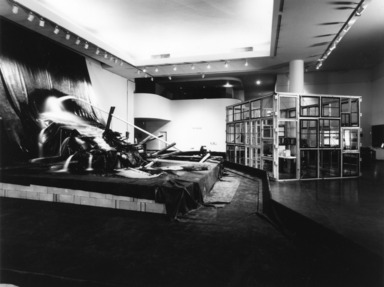

Meg Webster: Running, September 25, 1992 through January 03, 1993 (Image: PHO_E1992i017.jpg Brooklyn Museum photograph, 1992)
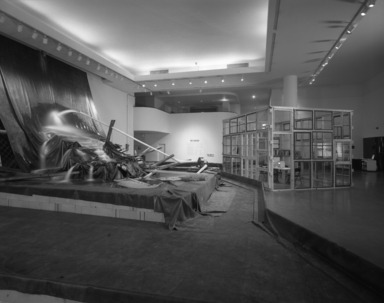
Meg Webster: Running, September 25, 1992 through January 03, 1993 (Image: PHO_E1992i018.jpg Brooklyn Museum photograph, 1992)
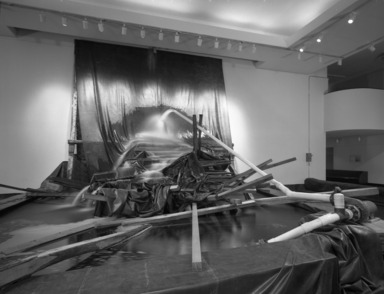
Meg Webster: Running, September 25, 1992 through January 03, 1993 (Image: PHO_E1992i019.jpg Brooklyn Museum photograph, 1992)
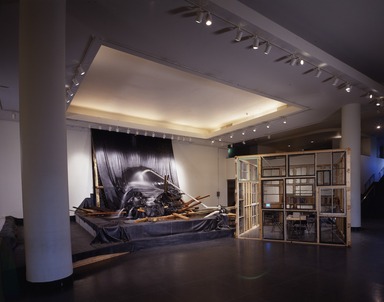
Meg Webster: Running, September 25, 1992 through January 03, 1993 (Image: PSC_E1992i006.jpg Brooklyn Museum photograph, 1992)

Meg Webster: Running, September 25, 1992 through January 03, 1993 (Image: PSC_E1992i032.jpg Brooklyn Museum photograph, 1992)
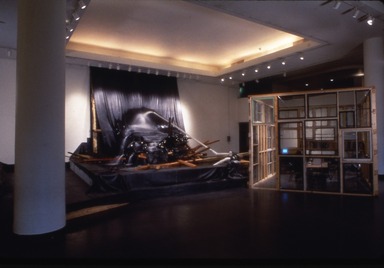
Meg Webster: Running, September 25, 1992 through January 03, 1993 (Image: PSC_E1992i033.jpg Brooklyn Museum photograph, 1992)

Meg Webster: Running, September 25, 1992 through January 03, 1993 (Image: PSC_E1992i105.jpg Brooklyn Museum photograph, 1992)

Meg Webster: Running, September 25, 1992 through January 03, 1993 (Image: PSC_E1992i106.jpg Brooklyn Museum photograph, 1992)
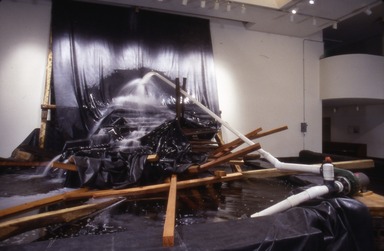
Meg Webster: Running, September 25, 1992 through January 03, 1993 (Image: PSC_E1992i107.jpg Brooklyn Museum photograph, 1992)
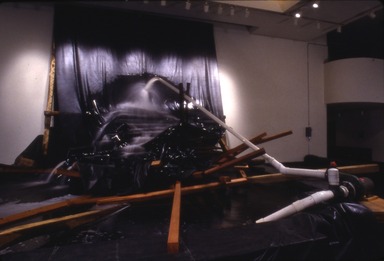
Meg Webster: Running, September 25, 1992 through January 03, 1993 (Image: PSC_E1992i108.jpg Brooklyn Museum photograph, 1992)
Meg Webster: Running
-
September 1, 1992
In Running, sculptor Meg Webster critiques and pairs nature and technology so that each is in service to the other and both are deployed to support humankind. This Grand Lobby project continues the tradition the artist has established in her previous sculptures and installations of using nature as one of her media: Webster has worked with soil, hay, salt, sand, and water. Here, the integrity of the natural materials is enhanced by incorporating machines (a computer and an electric pump) into the installation so that the viewer may learn more about nature and the environment through technology. According to Webster, “It’s not technology that’s destroying things. It’s our disregard for not finding a way to integrate ourselves into the ecosystem.” In Running, where one might anticipate a standard conflict of man versus nature, there is instead a symbiosis.
The use of natural materials has become Webster’s signature medium. She was born in San Francisco in 1944 and received her bachelor of fine arts degree in 1976 from Old Dominion University in Norfolk, Virginia. Prior to beginning her master of fine arts degree, which she received from Yale in 1983, Webster lived in San Francisco and Florida, where she painted and also started to make sculpture by bringing beach sand into her studio. When she was in graduate school in the early 1980s, Webster was a student of sculptor David von Schlegell. While at Yale she also heard lectures by Vito Acconci, Hans Haacke, Robert Irwin, Donald Judd, and Richard Serra, artists whose work had become prominent in the 1960s and 1970s and whose projects were quite different from those of the early 1980s art scene. In 1983, Webster was an assistant to Earth Work artist Michael Heizer. While her work is indebted to Earth Art, she has also been called a Post-Minimalist because of the influence of Minimalism on her art and the geometric elements in her sculpture. Webster, whose studio is in Brooklyn, has said that early Happenings, Conceptual Art, and Process Art were also important to her work.
By maintaining an allegiance to those styles, Webster can be called the torchbearer of previous movements. She has said, “It’s almost as if I stepped out of time and then came back in and started the dialogue again.” While Webster’s intentions may derive from the activist climate and the art activity of the late 1960s and 1970s, her project is not caught in a time warp. The issues she raises, while partially rooted in previous debates—of art movements, nature versus culture, man versus machine, and environmental concerns—are fresh and provocative when analyzed through the prism of this work. It is Webster’s ability to nod in the direction of art history while simultaneously injecting a vitality of form and content into her sculpture that enables contemporary concerns to be addressed.
Webster’s work has often concentrated on the cyclical aspects of nature as it grows and mutates. At Pittsburgh’s Mattress Factory in 1984, she created large geometric enterable forms out of organic material. In 1986, at Art Galaxy in New York, Webster organized Circuit, a five-part installation that took place over a two-month period. Each piece included different materials: water, earth, compost, food, and live animals were each employed to suggest change in life and nature. In her geometric permanent sculpture, Webster has frequently collected water in metal vessels to comment on the life span of a river or pond, as in her Water from a Dead Lake of 1989, which incorporated water from a polluted New York State lake. Her work has been included in numerous solo and group exhibitions, often to illustrate the revived interest by artists in the environment and the landscape. In the 1988 exhibition Sculpture Inside Outside at the Walker Art Center in Minneapolis, Webster made Moss Bed, an indoor sculpture, and Glen, an outdoor terraced work of flowering plants. Next spring, the first site in a large community garden she has planned will open in Atlanta. In this project, residents will participate by cultivating and harvesting vegetables and flowers. It is this interaction with the visitor that Webster seeks and that informs Running.
In this installation, which the artist sees as two complementary but distinct parts, a large stream is adjacent to a “resource room.” Made of found glass windows, the resource room houses books on the environment, planting and gardening, and small business operations as well as a computer to learn more about each subject. The windowed room becomes a metaphor for clear vision, for it holds the knowledge we are invited to acquire. Webster’s hope is that the resource room will engage museum visitors by welcoming them to create an entrepreneurial enterprise involving the planting and selling of vegetables, for example. With the information provided, the visitor has the tools to begin the process. Webster has said, “The idea is that the resource room is not just about learning, but hopefully a place to focus one’s movement in a joint enterprise. One could sit down at a table with three people and decide, well, we could do this work here and make this business here.” Indeed, the title of the installation alludes to both “running” a business and “running” water.
It is the flowing stream of water that provides the focus of this installation. Built of a wooden support, a construction of Butyl rubber holds the water and an electric pump circulates it throughout the piece. According to Webster, the work “needs to be large enough and active enough to compete with the space” of the Grand Lobby. “It isn’t just the size of the space, it’s the whole building that stands behind it. You are standing within a large, grand building.” That stream, because it is held in check by the artist’s structure and is indoors, becomes a sign of nature. Webster is aware that because she brings natural elements indoors, there is a noncontextual aspect to the work as it becomes what curator Vicky A. Clark calls “constructed nature.”¹ Yet Webster sees this piece as calling attention to environmental issues and our ability to participate by taking action through the resource room: “Whether you call my work environmental in the sense of my being a spokesman for it, I’m not sure. I do know these notions from within, and certainly Water from a Dead Lake spoke to it. But it isn’t just the calling up of those things. It’s the attention toward and experience with and emotional care of materials and its form.”
Twenty-one years ago, in his book The Closing Circle, Barry Commoner was prescient when he wrote, “In the eager search for the benefits of modern science and technology we have become enticed into a nearly fatal illusion: that through our machines we have at last escaped from dependence on the natural environment.”² Today, activism by scientists and environmentalists has put terms like the “greenhouse effect” and “global warming” into popular parlance. Webster’s work is not an example of one of these environmental problems, nor is it a scientific experiment. Her work stands as an art installation of pointed juxtapositions that evokes current issues. Visitor participation will be the key to the flow of information, manifested through the metaphor of flowing water. Each aspect of Running is a hum of activity that complements the other so that as the water source is analyzed, so is the source of our knowledge.
1. Vicky A. Clark, Meg Webster, exhibition brochure from the Forum series, Pittsburgh, The Carnegie Museum of Art, July 1-September 8, 1991, p. 1.
2. Barry Commoner, The Closing Circle: Nature, Man and Technology. New York, Alfred A. Knopf, 1971, p. 15.
All artist quotations are from a conversation with the author on August 11, 1992.
BROOKE KAMIN RAPAPORT
Assistant Curator of Contemporary Art
Pamela S. Johnson, a curatorial intern funded by the Lila Wallace-Reader’s Digest Fund, assisted in all phases of this project. This Grand Lobby installation and its associated Artist-in-Residence program are made possible by the Lila Wallace-Reader’s Digest Fund.
Brooklyn Museum Archives. Records of the Department of Public Information. Press releases, 1989 - 1994. 07-12/1992, 243-247.
View Original -
September 1, 1992
Sculptor Meg Webster (b. 1944) will create an installation in The Brooklyn Museum’s Grand Lobby that will encourage visitors to learn more about the environment, nature, and gardening. The installation, entitled Running, will be the Museum’s thirty-first Grand Lobby project and will be on view September 25, 1992, through January 3, 1993. It is composed of two complementary but distinct parts, a large-scale flowing stream of water and an adjacent “resource room” containing books on the environment, planting, gardening, and small business operations, as well as a computer to learn more about each subject. The title of the installation suggests both “running” a business and “running” water.
The stream, a symbol of nature, is the focus of the installation. Combining nature and technology, Webster will create a flowing stream with an electric pump, sheets of Butyl rubber, and a wooden support structure. Adjacent to the stream will be the glass-windowed resource room providing information on the environment and how to start your own small business, like planting vegetables, to sell at a local greenmarket, for example. “The idea is that the resource room is not just about learning,” said Meg Webster, “but hopefully a place to focus one’s movement in a joint enterprise. One could sit down at a table with three people and decide, well, we could do this work here and make this business here.”
The combination of machinery—represented by the electric pump and the computer in the resource room—and natural elements—represented by the flowing stream—allows the viewer to learn more about the environment through technology. According to Webster, “it[']s not technology that’s destroying things. It’s our disregard for not finding a way to integrate ourselves into the ecosystem.”
Webster was born in San Francisco and received her bachelor of fine arts degree in 1976 from Old Dominion University in Norfolk, Virginia, and her master of fine arts degree in 1983 from Yale University. While her work is indebted to Earth Art, she has also been called a Post-Minimalist. Webster has said that early Happenings, Conceptual Art, and Process Art were important to her work.
The Grand Lobby project was organized by Brooke Kamin Rapaport, Assistant Curator of Contemporary Art, with the assistance of Pamela S. Johnson, a curatorial intern funded by the Lila Wallace-Reader’s Digest Fund. The exhibition and its associated Artist-in-Residence programs are made possible by the Lila Wallace-Reader’s Digest Fund.
Brooklyn Museum Archives. Records of the Department of Public Information. Press releases, 1989 - 1994. 07-12/1992, 241-242.
View Original
